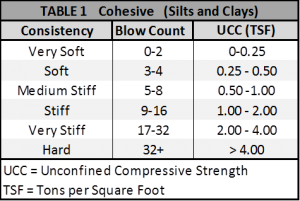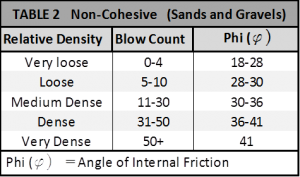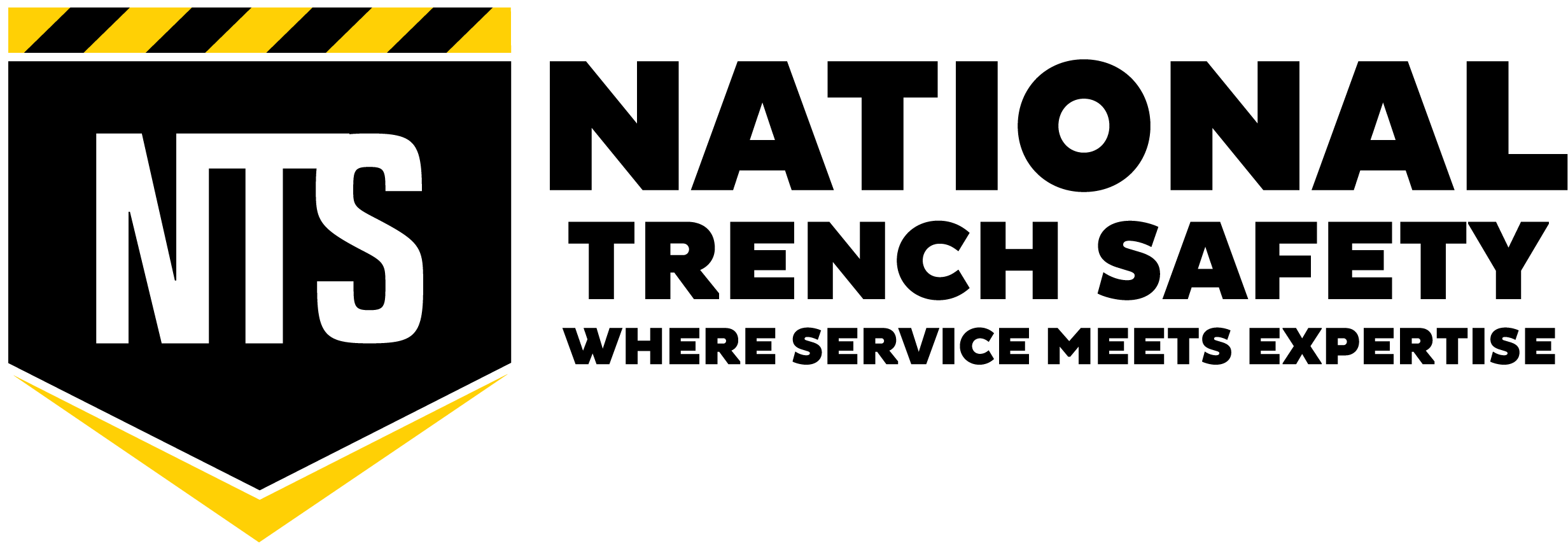Excavation support and shoring decisions can be complicated. The number of soil conditions and variables that go into defining the problem and the shoring system alternatives to choose from can be overwhelming. The results of getting it wrong can be very expensive while being overly cautious can result in not getting awarded the job or excessive costs when you do get the job. This article discusses the process of shoring situation definition and resolution.
Shoring system problems are usually first defined and cost-effective solutions are derived during the estimating and bidding process. There are six major questions that should always be asked and answered:
- Is the soil cohesive or non-cohesive?
- Where is the water table?
- Will the soil stand up long enough to install the shoring?
- What are the clear access dimensions I need inside the excavation?
- What are the consequences of deflection and ground movement?
- Is there a stable bottom?
The answer to these questions should lead an estimator to a reasonable cost-effective solution for the project. Some of the possible alternatives are listed in approximate order of increasing gross equipment cost (actual cost benefits and ordering for each system will differ based on the specific project):
Insertion Systems:
- Open cut
- Hydraulic shores
- Buildable aluminum boxes
- Trench shields
- Slide rail systems
Driven Systems (AKA Brace and Sheeting ):
- Shield and plate behind
- Pile and plate or lagging
- Sheet pile guide frame
- Sheet pile
Here is how one could answer the questions at bid time using the plans and specifications and the soils report:
1. Is the soil cohesive or non-cohesive?
Focus on the soil in the layer closest to the bottom of the excavation. On a bore log look at the description, cohesive soils are described in terms of consistency. Look for the  words very soft, soft, medium stiff, stiff, or very stiff (Table 1). If the soil is non-cohesive it will be described in terms of density as very loose, loose, medium dense, or very dense (Table 2). These terms are the “tell” for this most basic cohesive or non-cohesive soil type division.
words very soft, soft, medium stiff, stiff, or very stiff (Table 1). If the soil is non-cohesive it will be described in terms of density as very loose, loose, medium dense, or very dense (Table 2). These terms are the “tell” for this most basic cohesive or non-cohesive soil type division.
Why does it matter? The two different soil types behave totally differently and almost  opposite to each other. Two very basic differences are:
opposite to each other. Two very basic differences are:
- Cohesive soils derive their strength from the electronic bond in clay particles, while non-cohesive soils stand up due to friction between the soil particles
- Cohesive soils do not give up water easily, they can usually be dewatered from inside the excavation using sumps regardless of the water table while non-cohesive soils give up or allow water to flow easily and therefore requires more expensive and aggressive dewatering strategy in high water tables, usually from wells outside the excavation
There are many other differences between these soil types; however, just these two alone can have a tremendous effect on the cost of the shoring system.
2. Where is the water table?
In most all cases if the water table is above the bottom of the excavation it has to be lowered in the area of the shoring to typically 2-ft below the bottom of the excavation. In clay soils, this is fairly easy to do by directing the seeping water inside the excavation to a sump and pumping it out. With non-cohesive soils, the contractor will consider dewatering wells drilled outside the excavation and pumping costs. Also consider the possibility of having to use a sheet piling shoring system to slow or cut the water off, insertion systems that end at the bottom of the excavation will not cut off water flows.
3. Will the soil stand long enough to install the shoring?
Cohesive soils stand longer and better than non-cohesive soils. The ability for the soil to “stand” long enough to insert the shoring is critical to the success of using hydraulic shores and shoring boxes. Where the soil will not stand slide rail becomes an even more cost-effective alternative. Base stability is determined by the strength of the soil below the base level. Soil strength and “stand-up ability” is fairly easily determined by looking at the boring log and comparing the layer descriptions and blow counts to Tables 1 and 2 shown above. If the description for a clay layer is very soft or soft there can be problems with deep excavation cuts before inserting the shoring. Very soft is also an indication of a very high potential for bottom heave. In non-cohesive soils, very loose will not stand up and loose soils will need at least 8 percent “fines” in order to stand up in trenches less than 10 feet deep long enough to set hydraulic shores or shields.
4. What are the clear access dimensions I need inside the excavation?
Pipe comes in various lengths, bore pits usually require around a minimum of 20-ft clear dimension to lower in pipe and equipment. Buried concrete structures have to be constructed in lifts and require a 3-ft clear of the finish dimensions to construct formwork.
There are limitations in the width and spacing of shoring systems. Some general guidelines include:
- Hydraulic shoring is limited to widths of less than 12 ft on center, while the best spacing is usually 8 ft on center. Vertical clearance is limited to a maximum 4 ft.
- Trench shields 16-ft long and less generally allow for 20-ft long spreaders, while shields longer than 16-ft are generally limited to 16-ft spreaders. Vertical clearances are approximately 5 ft and if the shields are held 2 ft off the bottom 7-ft can be available
- Slide rail strut spacing can be up to 24 ft with clearances up to 12 ft
- Brace and sheeting systems using 14-in deep I-Beams typically have wale level spacing at 8 ft on center and 8-ft strut spacing
- Cantilever (no wale or strutting) sheet pile and pile and plate are generally limited to 12-ft depths. After that deflection and resulting ground movement is too much.
Do not ignore the fact that pipe bedding and structure bedding are approximately 12-in deep and that the shoring system needs to go to the full depth of the excavation. There is usually a provision for base stabilization where there is a potential for a soft or wet base that can trigger an additional 2 to 4 ft of excavation and backfill.
5. What are the consequences of deflection and ground movement?
All excavation work causes ground movement. As a general rule, the effect of these movements can be ½ to 1 times the depth of the excavation in non-cohesive soils and 1 to 2 times the depth in cohesive soils. The results of movements are structure settlement, concrete flatwork and foundation cracking, and movement of pipelines. In extreme cases, water main breaks and high-pressure gas line leaks can be created that result in extremely dangerous life-threatening situations. Along street projects, deflections along the trench wall cause the pavement section to break down, leaving pavement cracking and pumping that occurs long into the future.
The solution or mitigation to these problems is a more rigid protective system. A 20-ft trench shield or slide rail panel will deflect 2.5 times more than the same wall thickness of a 16-ft panel. Thin wall and lighter depth sheeting (2 to 4-in), such as aluminum and KDVI-8 sheet piling, used for sheeting in shallow excavations and at the end of shields will typically deflect if used in a brace and sheeting shoring system. In brace and sheeting shoring systems, the sheet pile thickness should be 3/8 in and the pile section depth greater than 8 in.
6. Is there a stable bottom?
With deeper excavations (typically those over 15 feet deep) determining whether there is a stable bottom is a critical question because dealing with unstable excavation bottoms can be extremely expensive. In cohesive soils a soft bottom will result in “bottom heave”, meaning the bottom rises up as you dig and the top settles. In non-cohesive soils and high water tables the bottom literally “boils” as water flows up. The only solution to this is sheeting, which is usually driven a minimum of 15 feet below the bottom of the excavation. If the chosen shoring system is a trench shield or slide rail and the bottom problems are discovered when they get to the bottom the system has to be removed and replaced with sheet piling or it has to be driven around the original system.
It is fairly easy to determine if there is a potential problem:
- In non-cohesive soils that are very loose or loose below the bottom of the excavation coupled with a high water table, there can be a boiling problem
- In cohesive soils when the unconfined compressive strength below the bottom is below 0.5 tons per square foot, (soft, less than 4 blows per foot) there is a potential for bottom heave.
When selecting a shoring system these 6 basic questions should always be asked and answered. If the answers are not clear and concise an engineer should be consulted to resolve the issues. National Trench Safety Engineering has engineers available to help assist a contractor with these questions. Sometimes with complicated shoring projects, it makes good sense to develop preliminary shoring plans when bidding on the project. These plans can provide better information that helps to produce more accurate estimates, reducing the potential for costly mistakes resulting from not properly addressing the impact a job site will have upon the trench safety system used.
DISCLAIMER: the information contained in this article is provided for general and illustrative purposes only and is not to be considered Site Specific and or designated engineering for any project or work zone, nor is it to be used or considered to be tabulated data, technical data, advice and or counsel to be used on any job site. Each project is different and is the responsibility of the employer’s designated Competent Person to make decisions on what systems and methods may be used in compliance with federal and local regulations, manufacturers tabulated data, engineered drawings, and other plans.





